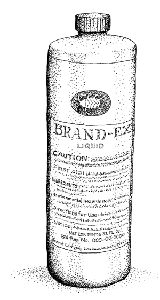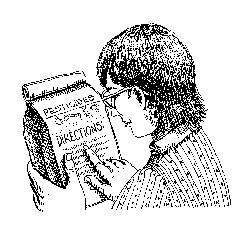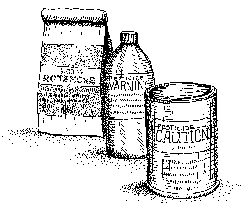 Understanding
Pesticide Labels
Understanding
Pesticide Labels
 What's on a Label?
What's on a Label?
 Understanding the
Label Helps Reduce Environmental Problems
Understanding the
Label Helps Reduce Environmental Problems
Research has shown that consumers find reading and understanding the label to
be the most difficult aspect of applying pesticides safely. However, an
understanding of the label information is essential before work begins. The
label printed on or attached to a container of pesticide tells how to use it
correctly and warns of any environmental or health safety measures to take.
Return to Table of Contents
The brand name is used on the front of the label to identify the
manufacturer's product. Type of formulation identifies the way the pesticide in
that container is mixed for application, usually in one of the following forms:
emulsifiable concentrate: an oil-based liquid which you mix with
water, then spray on affected plant
flowable or liquid: a liquid which you mix with water, then spray
soluble powder: a powder which you dissolve in water, then spray
granules: no mixing required, apply dry
solution: ready-to-use liquid; often in a spray bottle
 aerosol: ready-to-use spray, in
a spray can
aerosol: ready-to-use spray, in
a spray can
Ingredient statement lists the names and amounts of the active
ingredients and the amount of inert ingredients. Comparing the cost per unit of
active ingredient on different brands and formulations can save money, but don't
buy more than you need just to reduce cost-per-unit; you may end up creating
serious disposal problems.
The active ingredient in a pesticide has a complex chemical name derived from
its chemical composition; it may have a common name which makes it easier to
identify. One pesticide may be sold under different brand names, but the same
chemical name will be on all of the product labels.
Net contents indicates the amount in the container.
The law also requires the maker or distributor of a product to print the name
and address of the company on the label, along with an establishment number
telling which factory made the chemical. An EPA registration number shows that
the product has been registered with the Environmental Protection Agency for the
uses listed on the label.
The signal word and symbol on the label tell how toxic a product is. Signal
words to look for are danger along with the word poison and the skull and
crossbones symbol (highly toxic), warning (moderately toxic), and caution
(slightly toxic).
If the product is harmful to swallow or inhale or can damage eyes or skin,
the label contains emergency first aid measures and states exposure conditions
requiring medical attention.
The label tells how to avoid damage to the environment. Some examples: "This
product is highly toxic to bees exposed to direct treatment or residues on
crops." "Do not contaminate water when cleaning equipment or when disposing of
wastes." "Do not apply where runoff is likely to occur."
Physical and chemical hazards are listed and include specific fire,
explosion, and chemical hazards that the product may have.
The directions for use include the pests the product controls; the crops,
animals, or other items the product can be used on legally; how the product
should be applied; how much to use; and where and when the product should be
applied. This is often the most difficult part of the label to follow and,
therefore, needs special attention.
Application to harvest specifies the amount of time that must pass from the
time of application until it is safe to pick and use a food crop. Expressed as
"days to harvest," this is the time required for the residue to drop to safe
levels. It is often listed as a number in parentheses following the crop name. A
residue cannot be washed off.
The misuse statement is a reminder that it is a violation of Federal law to
use a product in a manner inconsistent with its labeling.
Storage and disposal directions must be followed for environmental and human
safety.
Return to Table of Contents

Home gardeners often use more pesticides per square foot in their gardens
than farmers do in the fields. Overapplication of a pesticide is a serious
mistake and a misuse of the product. Misuse of pesticides has a number of
adverse effects. It can cause health hazards, such as making food less safe to
eat, especially if there are residues at harvest time. It can also make handling
the plants more dangerous; each time a pesticide is sprayed, the gardener is
exposed to the dangers of inhalation or absorption of the toxin. Misuse can
cause various environment problems as well - beneficial insects, earthworms,
birds, and even pets may be harmed or killed along with the pests. Some
pesticides used near water may contaminate the water supply. Continuous use of
certain pesticides may induce resistance in the pests they are designed to
control, thus requiring the gardener to switch to more toxic substances. Some
pesticides do not break down easily and can remain in the environment for years.
Read the label when you purchase a pesticide, and again before mixing or
applying it. If you are confused about any part of the label, consult your
Extension agent or a representative of the product manufacturer. Many pesticides
now list a toll-free number for consumers. The label includes specific
information that you should be aware of and learn to understand.
 Read the label; it's the law. The
registration and use of pesticides are regulated by the United States
Environmental Protection Agency and the Virginia Department of Agriculture and
Consumer Services. Under the amended Federal Insecticide, Fungicide, and
Rodenticide Act (Federal Environmental Control Act of 1972), it is illegal to
use a pesticide on a crop unless the crop is listed on the label. It is also
illegal to exceed the given rate of application on the label.
Read the label; it's the law. The
registration and use of pesticides are regulated by the United States
Environmental Protection Agency and the Virginia Department of Agriculture and
Consumer Services. Under the amended Federal Insecticide, Fungicide, and
Rodenticide Act (Federal Environmental Control Act of 1972), it is illegal to
use a pesticide on a crop unless the crop is listed on the label. It is also
illegal to exceed the given rate of application on the label.
Return to Table of Contents
![]() Gardeners' Corner
Kids'
Garden
Sustainable Garden
Contact Us
Gardeners' Corner
Kids'
Garden
Sustainable Garden
Contact Us![]()



 aerosol: ready-to-use spray, in
a spray can
aerosol: ready-to-use spray, in
a spray can 
 Read the label; it's the law. The
registration and use of pesticides are regulated by the United States
Environmental Protection Agency and the Virginia Department of Agriculture and
Consumer Services. Under the amended Federal Insecticide, Fungicide, and
Rodenticide Act (Federal Environmental Control Act of 1972), it is illegal to
use a pesticide on a crop unless the crop is listed on the label. It is also
illegal to exceed the given rate of application on the label.
Read the label; it's the law. The
registration and use of pesticides are regulated by the United States
Environmental Protection Agency and the Virginia Department of Agriculture and
Consumer Services. Under the amended Federal Insecticide, Fungicide, and
Rodenticide Act (Federal Environmental Control Act of 1972), it is illegal to
use a pesticide on a crop unless the crop is listed on the label. It is also
illegal to exceed the given rate of application on the label.